Uses by permission
October 12, 1492, Columbus recorded in his logbook the natives of San Salvador Island were given red caps and glass beads. This is the earliest written record of glass beads in the Americas. The Spanish explorer Hernando Cortéz landed on the coast of Mexico in the spring of 1519. His ships carried glass beads along with other European trade goods. The Spanish explorers Narváez in 1527 and De Soto in 1539 carried glass beads for trade with the native inhabitants of Florida.
NUEVA CADIZ BEADS:
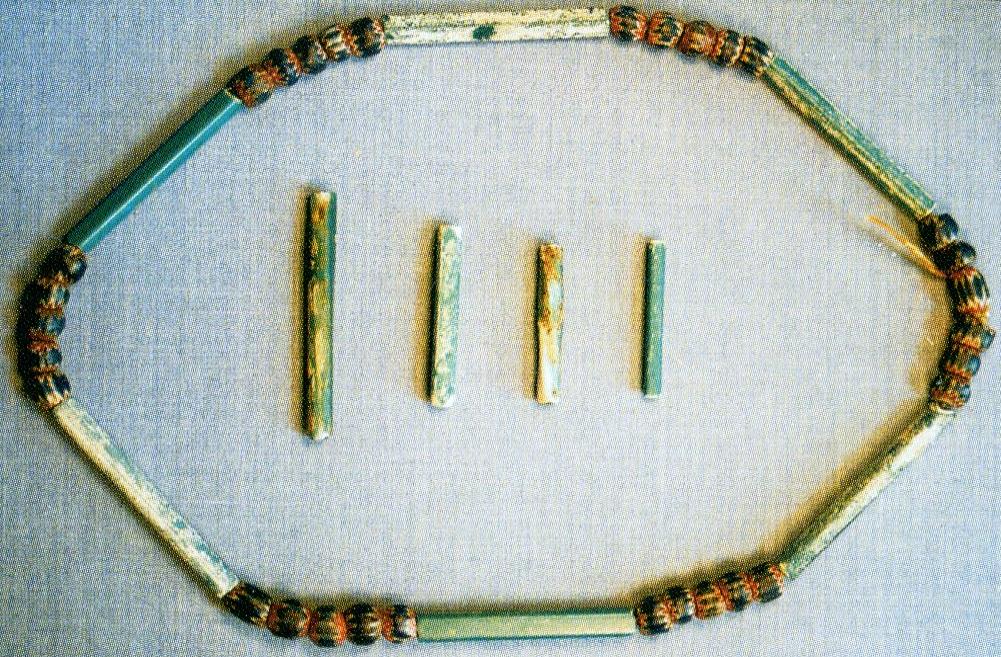
In 1622, a glass factory was built near Jamestown, Virginia. Less than a year later, a raiding party of Indians burned the factory. Very few of the beads made in the Jamestown factory are believed to exist today.
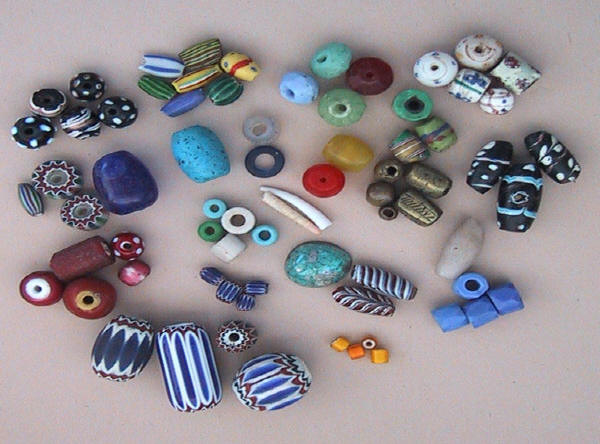
Early Spanish Conquistadors and Priests traveled from the Florida Keys to California. In 1741, the Russians reached the coast of Alaska and from there down the western coast of North America. A North West Company trader, Alexander Mackenzie, crossed Canada to the Pacific Ocean in 1793. All of these explorers, as well as David Thompson and the Lewis and Clark Expedition, carried glass beads for presents and as a medium of exchange in dealing with the American Indians.
LEWIS AND CLARK BEADS:
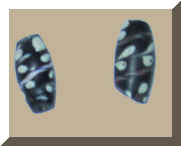
The Lewis and Clark expedition carried thirty-three pounds of small trade beads. There is no evidence they carried the bead pictured to the right, but these beads are known as Lewis and Clark beads. There are several entries in the various journals kept by the expedition members about how hard it was to trade for food with any of the beads they carried, except the plain and blue and white ones.
Bead prices varied with location, demand, and how bad Indians wanted a particular bead. When trading for beaver pelts, the Hudson’s Bay Company used a standard value based on made beaver…a made beaver was stretched, dried, and ready for shipment. Records from early trading posts show a made beaver was worth: six Hudson’s Bay beads; three light blue Padre (Crow) beads; two larger transparent blue beads.
Little historical information is available on the majority of trade beads discovered in archeological sites. The Hudson’s Bay Company has celebrated over three hundred years in North America, but the records on types and descriptions of trade beads, along with invoices, and sources of supply have not survived in the Hudson’s Bay archives. Today the company’s only examples of the Hudson’s Bay beads are in the Indian Arts and Crafts section of their museums.
Early Bead History:
The history of beads dates as far back as 40,000 years ago and have been made by every culture since then. Egyptians were making glass beads by 1365 B.C., and several thousand-year old glass factories in Lebanon are still in production. Evidence China has been making and exporting glass beads for centuries has been revealed in archaeology sites. Glass and Brass beads are found in burial sites of many cultures: Egyptian tombs, Roman catacombs, Saxon, African, and American Indian.

The above string of beads are made from mastodon bone. There is no indication that the beads were made at the time of the animal’s death.
Prior to European contact, beads in North America were made from gold, jade, bone, the blue-green turquoise, and hand polished shell beads. Anasazi, Fremont, and other Southwestern Pueblo people traded turquoise throughout the Southwest and into Mesoamerica. Indians from the Pacific coast traded sea shells to the Southwest Indians; Indians from the Atlantic coast and the gulf of Mexico traded beads to the Mound Builders of the Mississippi River valleys.
VENETIAN TRADE BEADS:
A major source of glass beads used in the fur trade was Venice, Italy. Venetians held a near monopoly on the bead industry for nearly 600 years. A guild of Venetian glass makers existed in 1224 A. D.. Around 1291, a large portion of the Venetian glass industry moved to Murano, an island north of Venice; city fathers feared an accident with one of the glass furnaces could destroy the city.
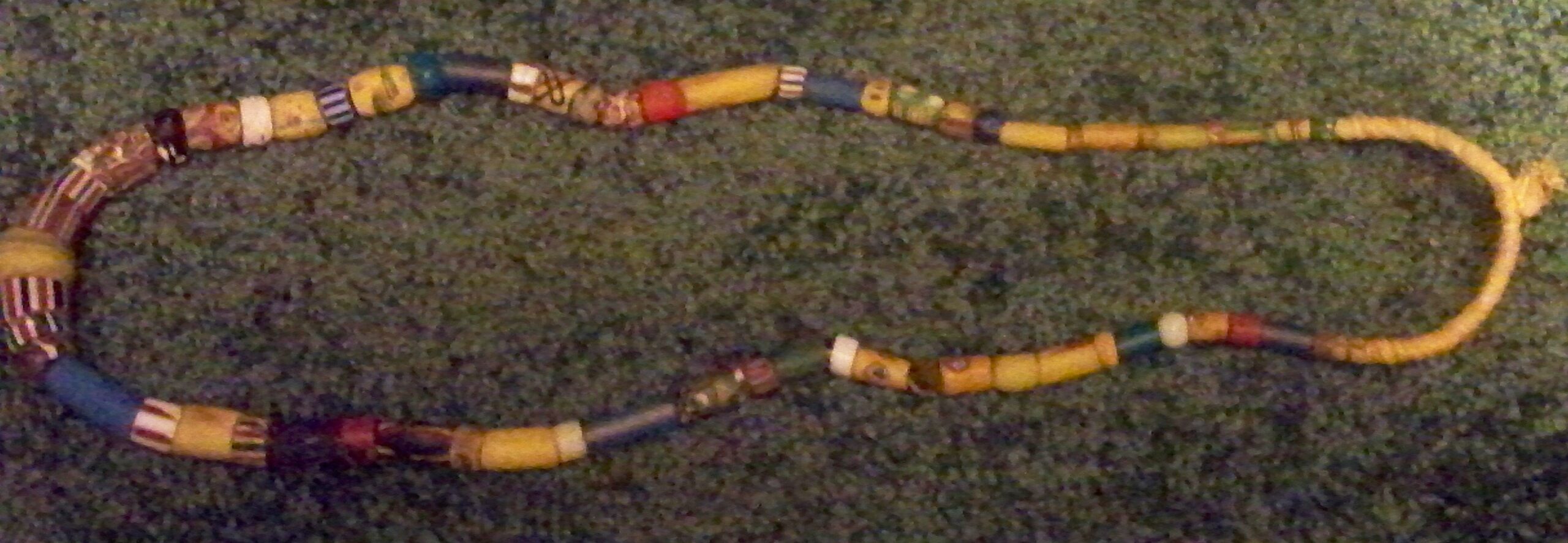
For over two hundred years, beads were made in Murano by a method known as “winding.” With this method, beads were made individually by drawing a molten glob of glass out of the furnace and winding it around an iron rod. Glass of another color could then be added, or the bead could be decorated with a design. Coloring agents were added to the molten glass: cobalt made blue; copper produced green; tin made a milky white; and gold resulted in red. Wound beads from a master glassmaker were so perfect it was hard to find a seam where the different molten glasses merged.
Another method was blown glass beads. Using this method, a glob of molten glass was removed from the furnace and the desired shape obtained by blowing through a glass tube—much the same way glass vases are made.
The glass industry was able to keep up with demand using these two methods until the mid- to late 1400’s. Once European countries started sending ships around the world, ship captains and explorers carried beads made of glass, porcelain, and metal to use as gifts, or for the fur trade. The slow method of winding beads could not keep up with this new demand.
Around 1490, Venetians started to make beads from tubes of drawn glass; Egyptians may have used this process centuries before. With this procedure, a master glassmaker took a glob of molten glass from the furnace and formed a cylinder. After working the cylinder into the desired shape, he attached a rod to the cylinder. An assistant took the end of the rod and run down a long corridor before the glass cooled. The drawn glass tube was about one hundred and twenty meters long. The length of the tube and the amount of glass used determined the size of the beads. Once the tubes cooled, they were cut into meter long pieces. These pieces were cut into beads of various sizes. The cut beads were placed in a large metal drum containing lime, carbonate, sand, carbon, and water. While the metal drum turned, heat was applied to the outside causing the rough-cut edges to be smoothed. After the beads were smooth, they were cleaned and then placed in a sack of fermented bran and vigorously shaken to polish them. The monochrome glass beads of today are not much different from those made five hundred years ago.
By the 1500’s, the demand for glass beads reached the point Venetians were sending drawn glass tubes to Bohemia. There the glass tubes were broken into beads, polished, and sent back to Venice. The Bohemians (Czechoslovakia) had been making glassware, vases, and cups since the twelfth century.
BOHEMIAN BEADS:
With an abundance of willing workers, quartz for the silicon base of glass, and potash from wood-burning furnaces, Bohemia sent men to work in the glass factories of Murano. The knowledge these men brought back on how to make the drawn glass tubes turned Bohemia into a major producer of glass beads. By the mid-eighteen hundreds, Bohemia was producing more glass beads than the factories in Murano.
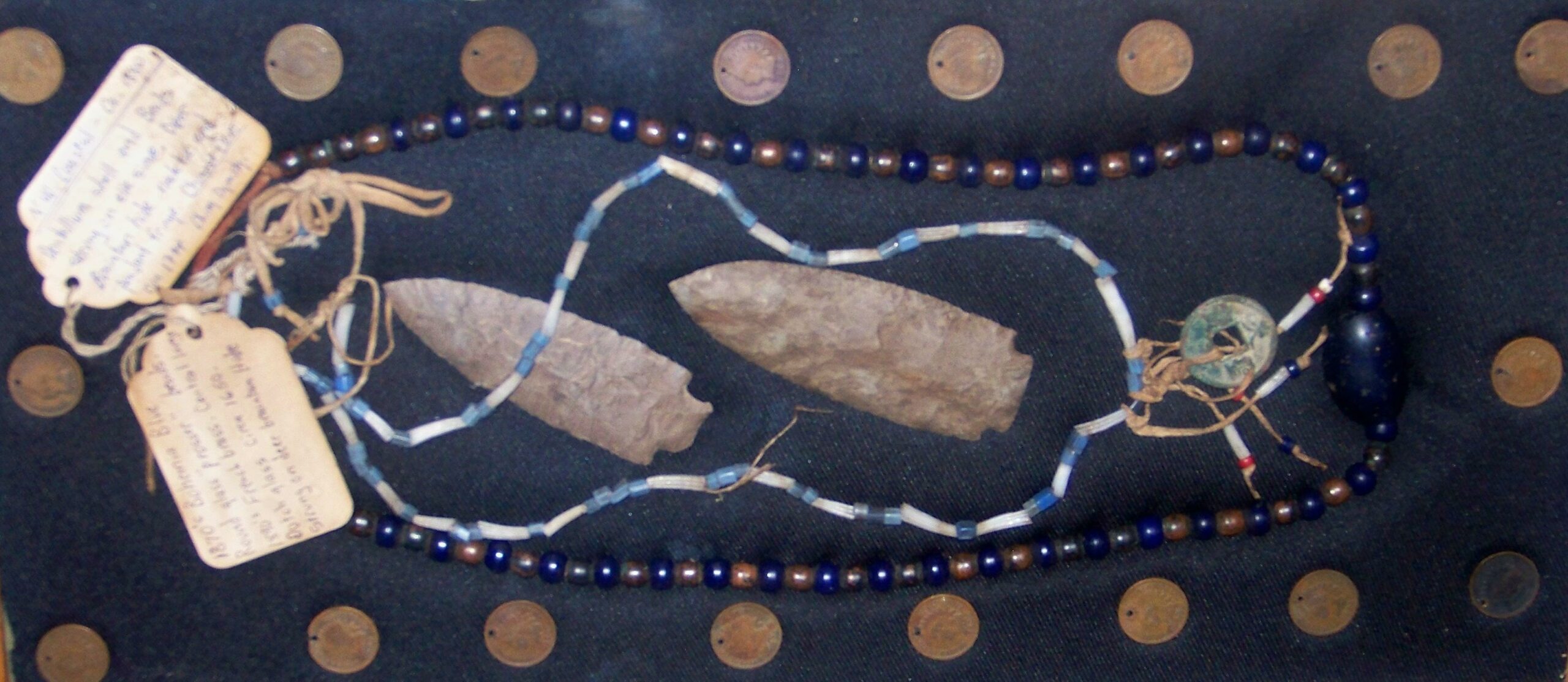
China was also a source of glass trade beads. Studies by Peter Francis, Jr., Director of the Center for Bead Research, has shown beads from China were brought to Mexico with the Spanish galleon trade. This trade route linked Chinese ports with Manila and Acapulco, and from there to the rest of the Spanish Empire in the Americas. Russians acquired Chinese beads from trading post on the Mongolian border and transported them to Alaska. A few Chinese glass beads have been found along with Venetian beads on Colonial Spanish 17th century sites…one of America’s top archaeologist, David Hurst Thomas excavated over 62,000 beads from St. Catherine, the northern most Spanish mission on the Atlantic coast.

These are Bohemian Blue beads with French brass trade beads, but they include a Chinese coin, a clear indication of contact with Chinese trade. The large blue bead at the top is a Dutch glass bead dating to 1650. The interior string consists of blue faceted trade beads strung with Dentalium shell beads. Dentalium shell was highly prized among Native Americans, especially the longer shells.
PADRE, DOGON, CROW, AND PONY BEADS:

Padre beads are wound, opaque, light blue glass beads from China. These beads come in three sizes: jumbo (Dogons) 5/8’s to 3/4 inch in diameter, mid-sized (Crow beads) 3/8’s inch in diameter, and small Pony beads 3/16’s inch diameter. Through Spanish and Russian traders, Padre beads spread rapidly into the Southwest and Northwest. In 1778, English explorer, Captain James Cook made several references to the effect it was difficult to obtain supplies and furs from the Pacific coast Indians without this particular blue bead. Captain Lewis had this to say about Padre beads and the Indians tribes along the Columbia River…only the blue and white beads were acceptable, the most desired, are the common cheap, blue beads called “Chief Beads”…. Padre beads were made in a variety of colors, but blue and white were the most sought after by the Northwest Indians.
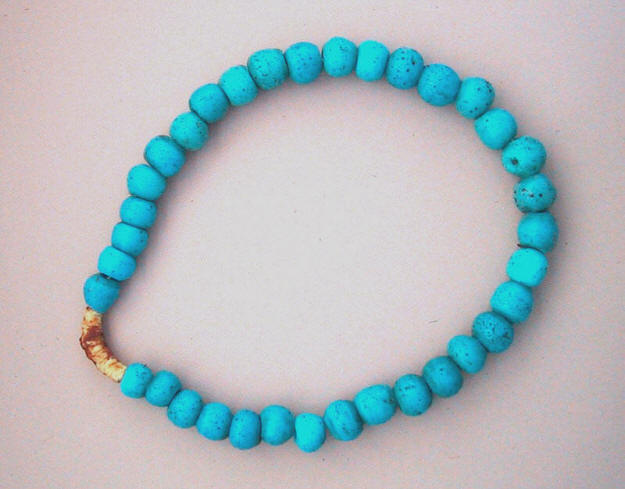
This string of jumbo Padre “Chief” Beads was a gift from Julie Birrer of Jackson Wyoming. The beads original came from the Nez Perce in the late 1700s. The Nez Perce referred to these beads as Sky-Blue beads.
CHEVRON BEADS
The aristocrats of the glass beads are the Chevron or Rosetta. They are also called Rosary or Star beads. The word “bead” is derived from the old English word “bedu” meaning prayer. These Paternoster beads are multi-layered and corrugated to produce a star pattern on the ends which often result in stripes on the outside. The original Chevron bead had seven layers. This hand-faceted bead was difficult to make, and in order to meet the demand, variations were made with as few as four layers. These new variations were tumbled instead of being hand-faceted to speed-up the process. The most common Chevrons are the blue, red, and white combination. Green and white (referred to as “water melon” beads) , or red and white, Chevrons are rare. Father DeSmet carried these beads in his work with the Plains and Northwest Indian tribes, but there is no evidence Chevron beads were used during the Indian fur trade period as a trade item.
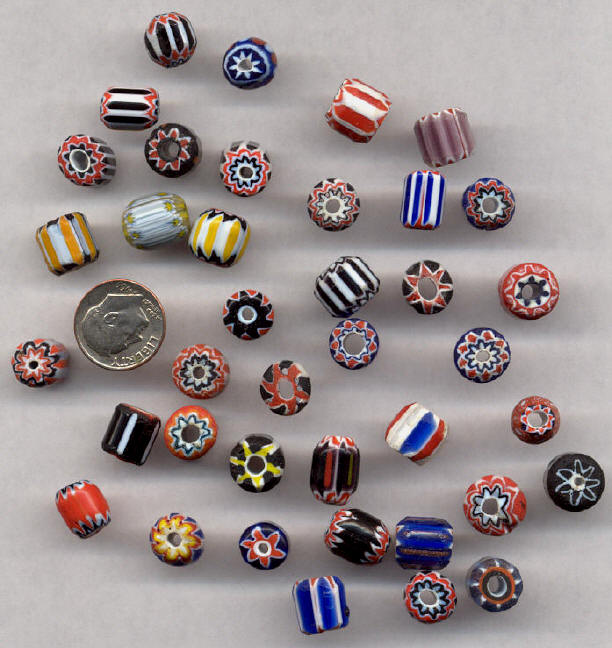
Although found in small percentages as late as 1640, Chevron beads are abundant only in sites earlier than 1600.
VASALINE or CAVE AGATE BEADS:
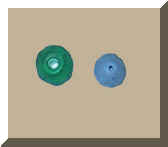
Another trade bead was the Vasaline, or Cave Agate. These beads range in a variety of colors. This pressed bead was faceted and transparent. On the earliest Vasaline beads, the hole through the bead is larger on one end; the hole was made with a hot pointed rod. Vasaline beads were widely traded until the mid-1800. After the mid-eighteen hundreds, Indians women requested the smaller seed beads.
RUSSIAN BLUE BEADS:

Russians had little to do with the Russian Blue beads. Produced in Bohemia, the Russian Blue bead did not appear in Alaska until just before Americans bought Alaska (1867). Russians traders acquired these beads from the American and English traders in exchange for furs. The Russian Blue beads are shaped into six-, seven-, or eight-sided tube before being drawn. After the tubes are cut to bead size, the ends of the ridge between the adjacent sides are ground off. The result is a bead with eighteen, twenty-one, or twenty-four facets. Some deviations resulted in more or less facets.
CORNALINE d’ ALEPPO or HUDSON’S BAY BEADS:

In the mid-1800’s, the “Cornaline d’Aleppo” beads became known as the Hudson’s Bay bead. This bead has two distinct colors of glass, one color over the other. The outer layer was red and the inner layer a translucent green. The more recent version of the Hudson’s Bay bead has a yellow or white center of opaque glass with the outside having a translucent or opaque red glass. This later version can be found in tubular, ovate, and spherical shapes and in a wide range of sizes.
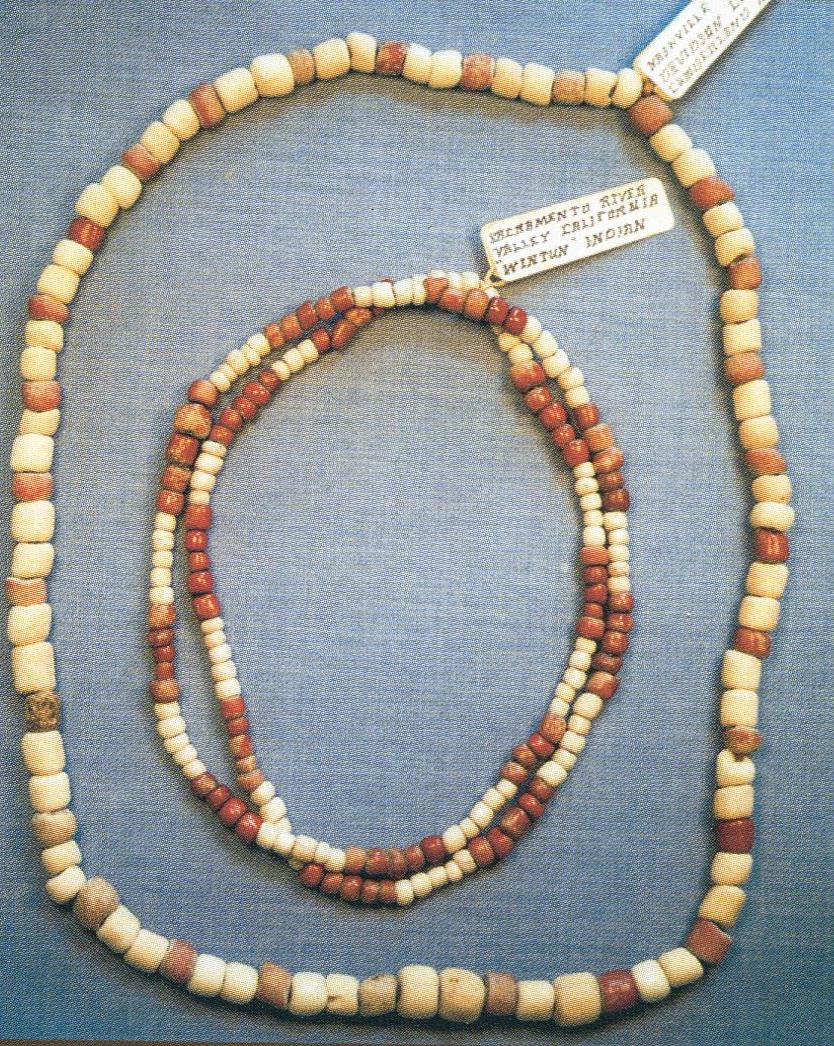
MILK GLASS TRADE BEADS:
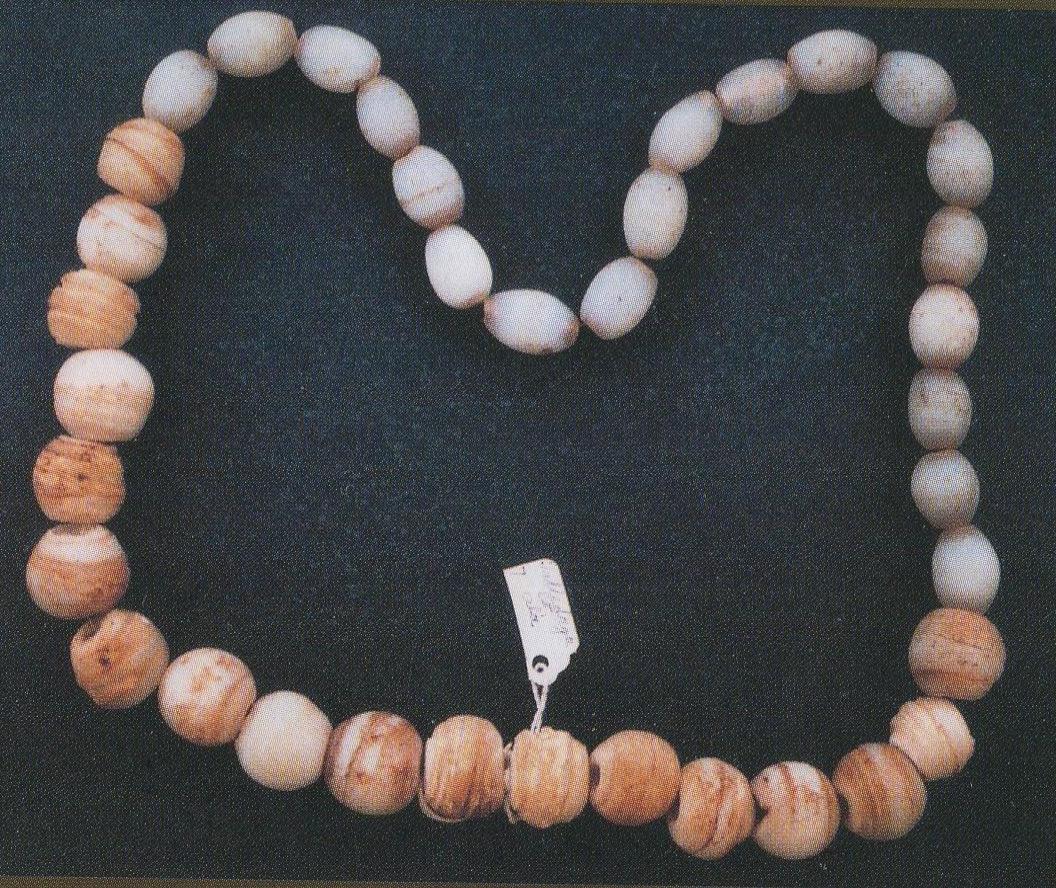
These are Milk Glass trade beads found in North Carolina. Historical data is difficult to obtain on many types of trade beads recovered from archaeological contexts.
RATTLESNAKE BEADS:
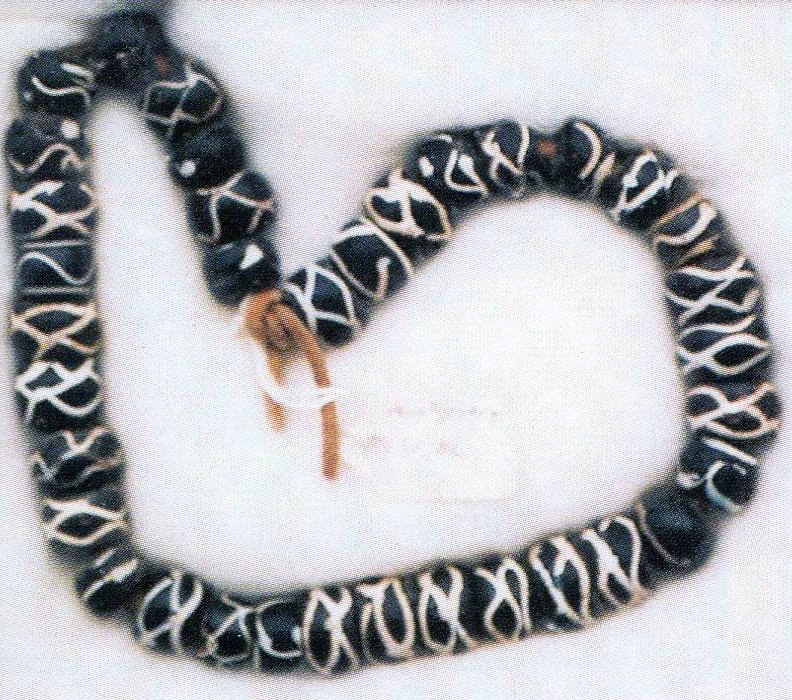
Rattlesnake beads get their name from the hand painted design along the outside of the bead. These beads are still produced today as bead art.
FEATHER BEADS
These beads get their name from their feather-like design. They were produced as part of the African bead market.
DUTCH “PILLOW TICK” BEADS:

These Dutch “pillow tick” beads were traded by the French in the western Great Lakes area between 1670 and 1760. The “pillow tick” name is derived from their design.
ENGLISH COLORED GLASS TRADE BEADS:
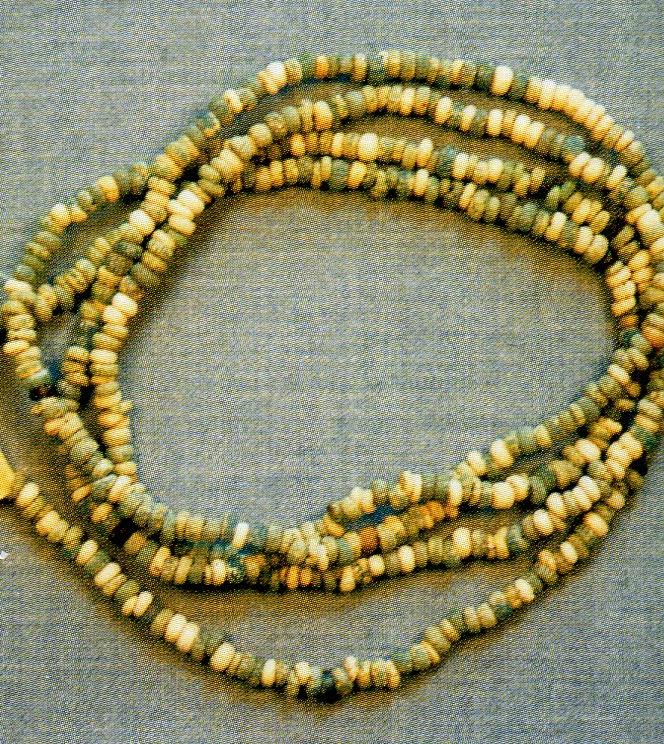
These beads were traded by the English in the area of Hiwassee Island, Tennessee.
HUBBELL BEADS:
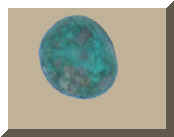
The last known bead made for Native American trade was the Hubbell bead. This bead was supposedly made for Lorenzo Hubbell owner of the Hubbell Trading Post in Gavado, Arizona. First made in Czechoslovakia between 1915 and 1920, this bead is still being made today. The Hubbell bead came in a variety of sizes, shapes, and shades to imitate a semi-precious stone…Turquoise. Records at the Hubble trading post do not support any connection with this bead.
MIX AND MATCH:
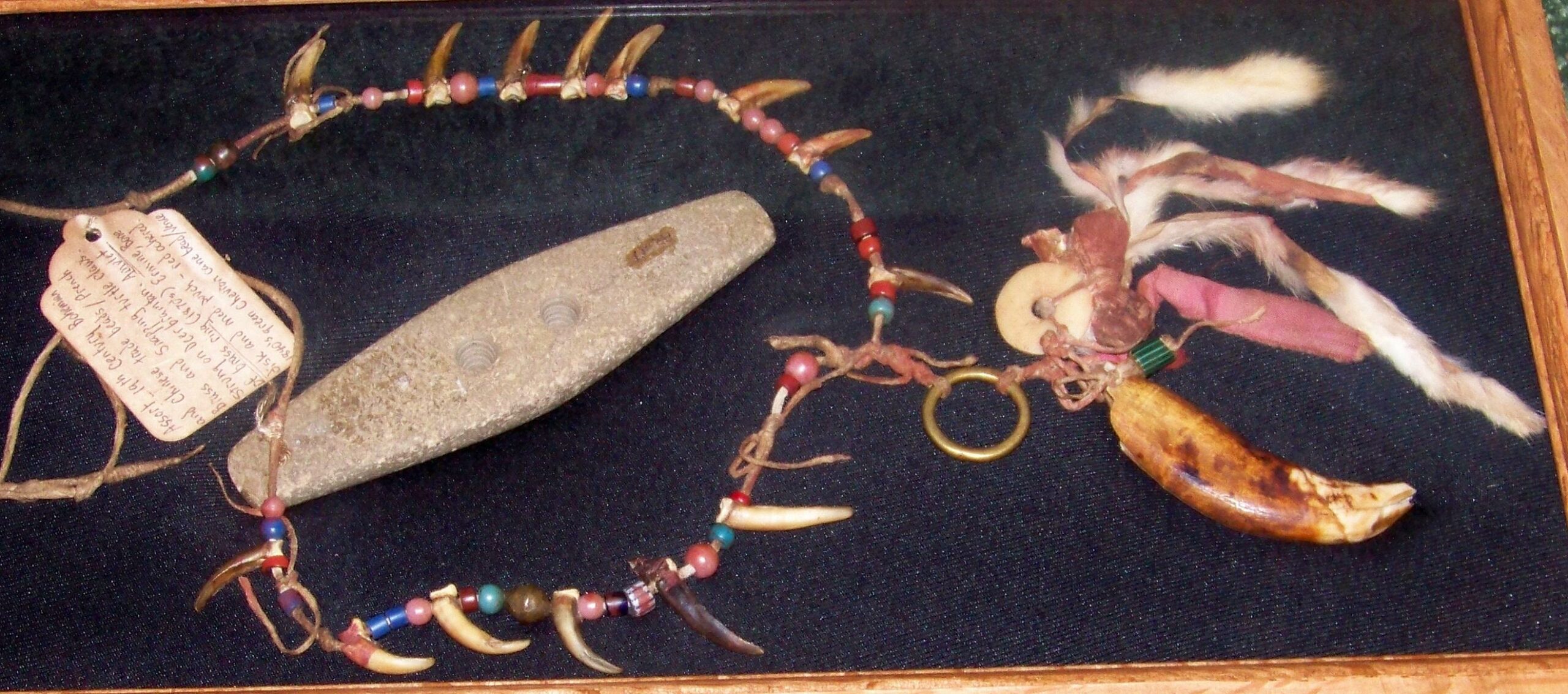
While some beads were strung using the same bead type throughout, more often beads were mixed with other bead types or beads of natural materials to form the final string. This is a classic example of mixing choices of various beads that were gathered over time. The string includes Bohemian blue beads, French brass beads (1870), green Chevron or “Water Mellon” beads, a brass ring, bear tooth, bone disc bead, Chinese Padre beads, Red Venetian beads (1840), snapping turtle claws, Milky Glass beads, and parts of a medicine bag.
Seed Beads:
Seed beads like those used on this deer skin bag reached the plains Indians in the mid-1840s. The use of stringed beads waned as Indian women began to use seed beads in the creation of designs.
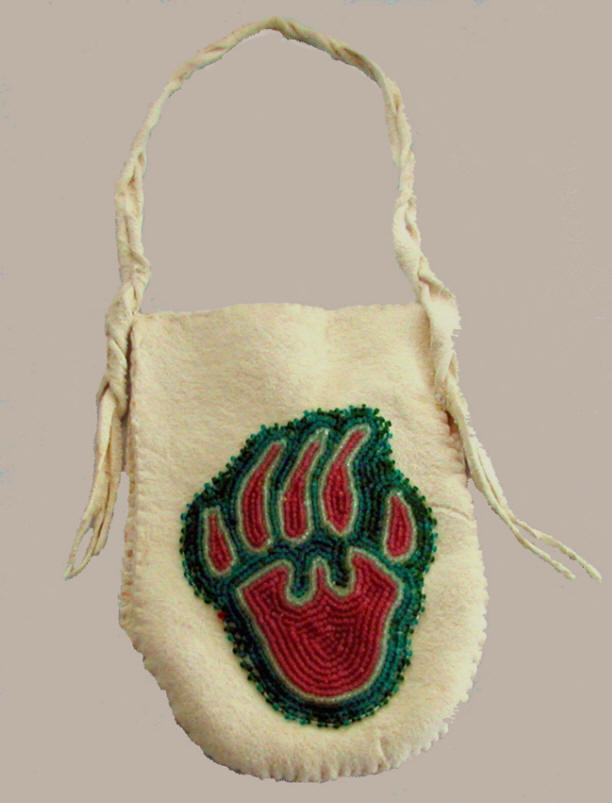
The primary beads used by Indian women for decoration were the seed, Pony, and Crow beads. Made of drawn glass: the seed beads were under 2.0 mm; Pony, or pound beads, were between 2 and 4 mm; Crow bead were 4 to 10 mm in diameter. The larger Crow and Pony beads were carried by Lewis and Clark and other early explorers. Crow and Pony beads were hung from, or attached to clothing and horse gear. There is no evidence of seed beads being taken to the Mountain Man Rendezvous during the period 1825 to 1840.

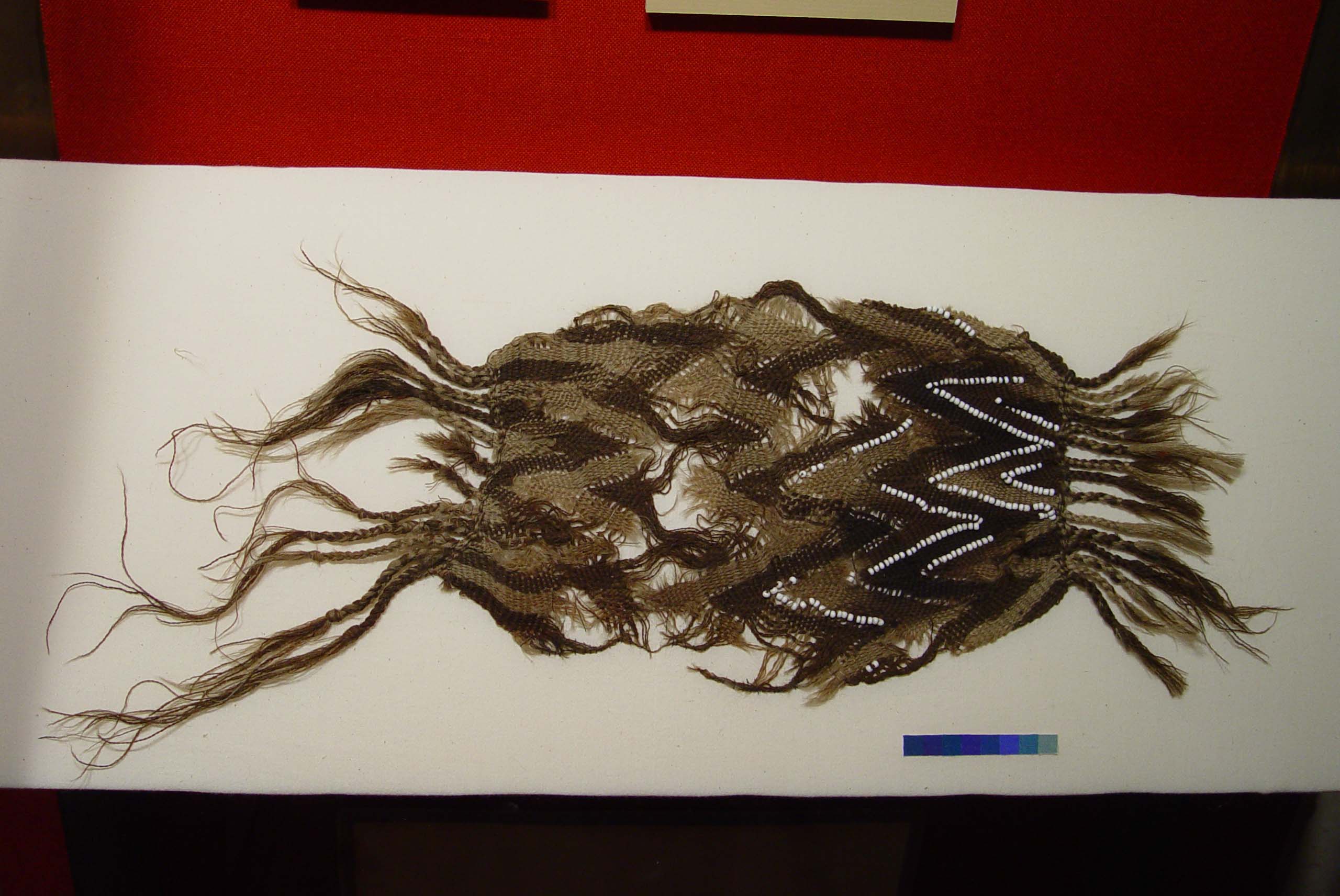
Prior to the introduction of seed beads, porcupine quill work was used in decoration by the Plains Indian women. Developed by the North American Plains Indians, quill work followed the introduction of horses. After acquiring horses, Plains Indian did not have to range over larger territories in search of game. Being able to spend more time in one place allowed women time to quill. Each tribe had its own patterns and traditions associated with the quill work. The advent of seed beads allowed for an expanding expression of design, especially among tribes of the Western plains. Below are just a few of those designs.

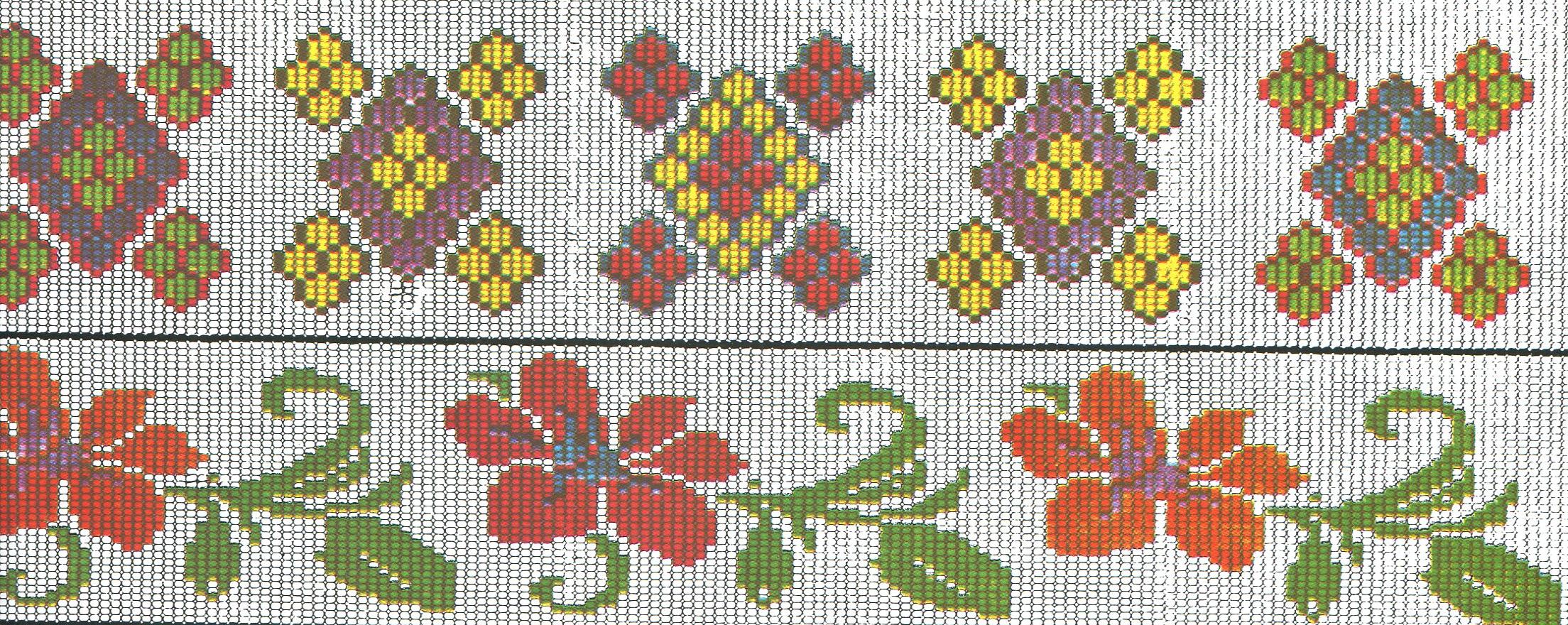
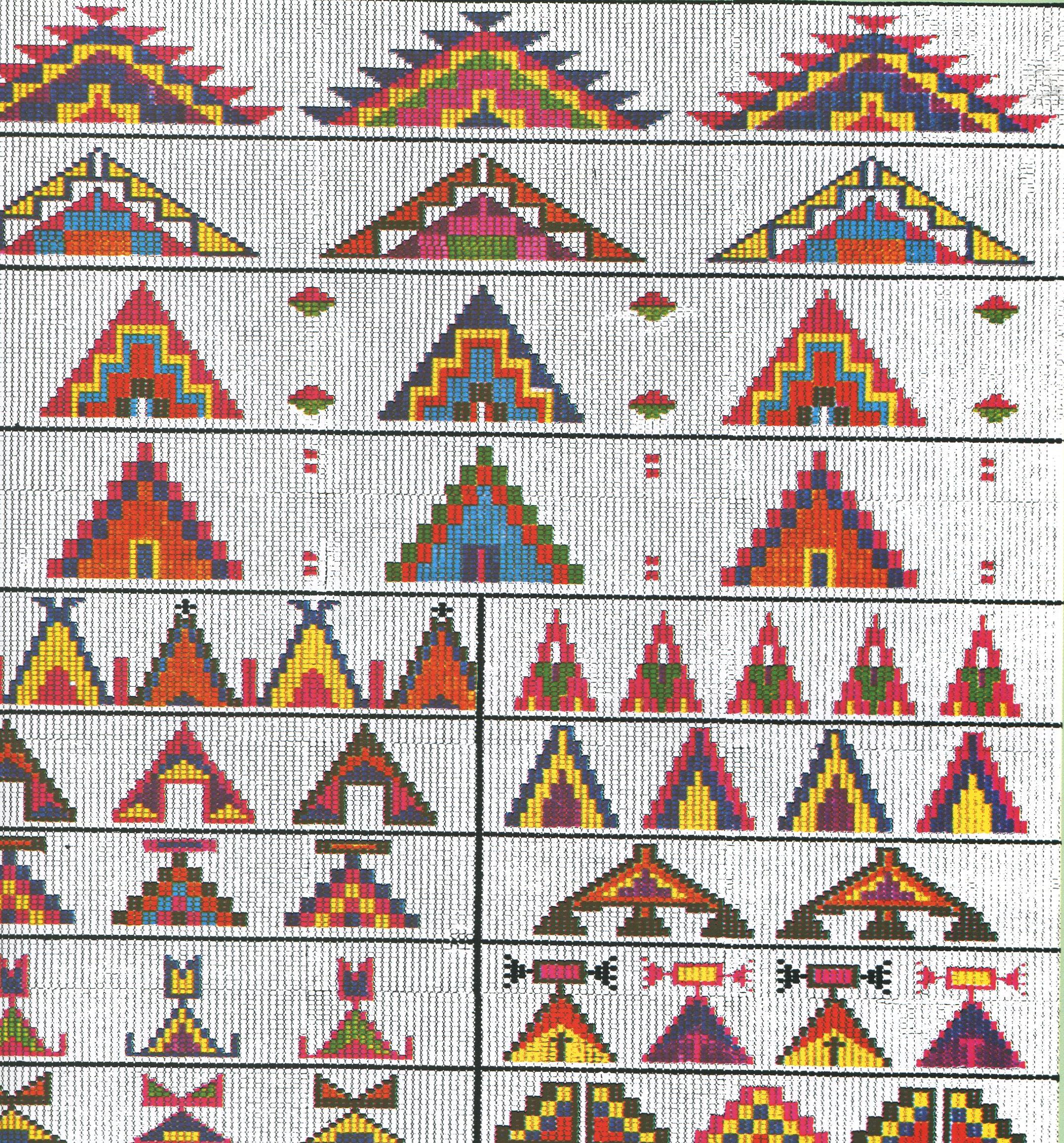
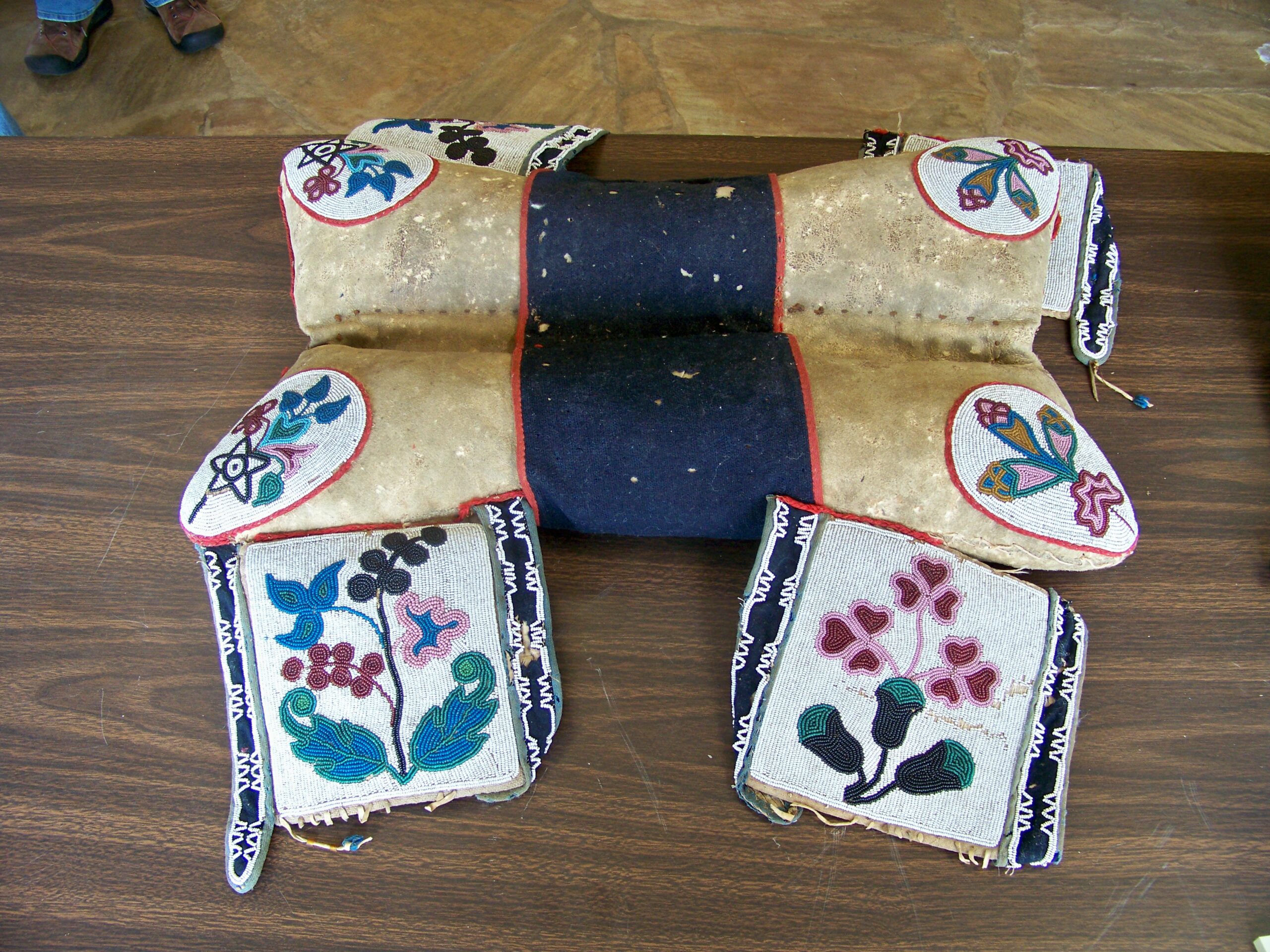
My thanks to Joan K. Murray, Corporate Historian, Hbc Heritage Services for updated information on Hudson’s Bay seed beads. In 1987, the Hudson’s Bay Company sold its Northern Stores Division to the North West Company. The successor to the Hudson’s Bay Company in Northern Canada still sells beads to Native Americans. The new North West Company stocks over forty colors of seed beads.


This thirty-five inch bandolier went around a horse’s neck. While on his way to the Columbia River and Fort Astoria in 1811, Wilson Price Hunt mentioned a similar decoration on a Cheyenne Indian horse’s neck. This pre-1885 Crow bandolier has on it: Crow beads, vasaline beads, French brass beads, white hearts, Mescal seeds, sea shells, Abalone shells, Dentalium shells, Dutch dogans, watermelon beads, hawk bells, thimbles, buttons, rifle shell casing, bullets, deer dew claws, and a pieces of an American flag.
WAMPUM:

Native Americans along the eastern coast had their own beads. These beads were made from the “quahog” or hard-shell clam. The hard-clam furnished two colors of Wampum—white and purple. Only a small portion of the shell could be used to make the purple bead, resulting in its value being twice the value of the white bead.
With the introduction of metal tools to drill and work the clamshell, the beads became more uniform, about one-fourth inch in length and one-eighth inch in diameter. The Dutch and English colonists established factories to speed up the production of Wampum, thus becoming one of the earliest industries in America. John Campbell and his descendants in New Jersey made the bulk of wampum beads traded in this country. Quahog-shells were also sent to Europe to be made into Wampum and then returned to the colonies.

Wampum beads were widely used for trade, but were not considered a form of money. These beads were used for personal decoration, and when arranged on a string in a particular color pattern to convey messages between various tribes. Wampum woven belts were often used in ratifying treaties. The arrangement of colors becomes the treaty document. There are records of court judgments and tuition in some of the early American colleges as being payable in Wampum. Beads of the quahog shell remained a medium of trade exchange until 1792, when the United States government established coinage laws bringing into use the first silver dollars and ten dollar gold pieces. Glass beads eventually replaced Wampum as a means of ornamentation.
MANHATTAN BEADS:
Many history books claim the Dutch bought Manhattan for twenty-four dollars worth of trade beads. This story first appeared in Martha Lamb’s book on New York history in 1877, which was two hundred and fifty years after the purchase. Since her book was published, most historians have quoted it. Manhattan was purchased with trade goods, but there is no evidence trade beads were more than a small part of the exchanged items. – Peter Francis, Jr. Bead Research Center.
The Indian Trade Bead article was written by O. Ned Eddins of Afton, Wyoming. Permission is given for material from this site to be used for school research papers.
References:
Wind River Rendezvous, St. Stephans Indian Mission Foundation, St. Stephans, WY.
Arizona Highways, July 1971.
Bead Research Center – Chinese Glass Beads: A Review of the Evidence by Peter Francis, Jr., Director of the Center for Bead Research. To reach this internet site, type into Google search- the bead site – and it comes up as Index-2, otherwise you are asked for name and password.
Native American Beadwork – Large Bibliography of Native American Beadwork. Mindy Callaway, Graduate School of Library and Information Science, University of Texas at Austin.
www.kstrom.net/isk/art/beads/art_bead.html – History Culture Values of Beads
www.sicc.sk.ca/saskindian/a97jun20.htm – History Of Indian Beads
www.hbcheritage.ca – HBC Heritage Services is a good source of information on the Hudson’s Bay Company.